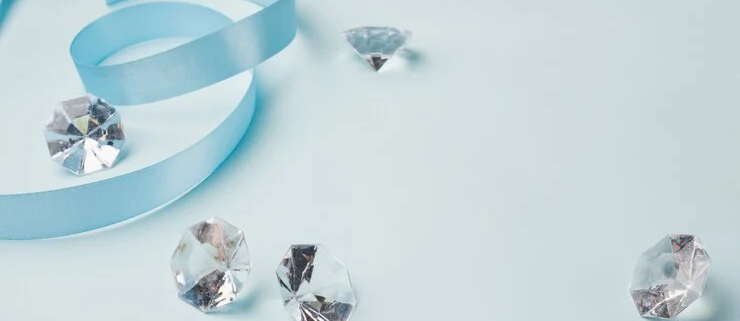The Ethical Choice: Exploring Lab-Grown Diamonds for Sustainable Luxury
In recent years, the jewelry industry has undergone a significant transformation driven by a growing demand for sustainable and ethical jewelry. As consumers become more conscious of the environmental and social impact of their purchases, they are seeking out alternatives to traditional mined diamonds. Enter lab-grown diamonds—a sustainable and ethical choice that offers the same beauty and brilliance as their mined counterparts without the environmental and moral concerns. In this blog post, we’ll delve into the world of lab-grown diamonds, exploring their origins, benefits, and the role they play in shaping the future of sustainable luxury.
The Concept of Lab-Grown Diamonds:
Lab-grown diamonds, also known as synthetic or cultured diamonds, are created using advanced technology that replicates the natural diamond-growing process. Unlike mined diamonds, which are formed deep within the earth over millions of years, synthetic diamonds are produced in controlled laboratory environments in a matter of weeks.
The process begins with a tiny diamond seed, which is placed in a high-pressure, high-temperature chamber along with a carbon source. Through a combination of heat and pressure, carbon atoms bond to the diamond seed, gradually growing into a larger crystal. The result is a diamond that is chemically and structurally identical to its mined counterpart, with the same exceptional brilliance, clarity, and durability. As consumers become increasingly conscious of the origins of their luxury goods, synthetic diamonds have emerged as a compelling choice for those seeking ethical jewelry options.
The history of Synthetic Diamonds
Lab-grown diamonds date back to the mid-20th century when scientists began exploring methods to recreate the conditions under which natural diamonds form deep within the Earth’s crust. While the concept of creating synthetic diamonds had been proposed as early as the late 19th century, it wasn’t until the 1940s and 1950s that significant advancements were made in diamond synthesis techniques.
In 1954, scientists Herbert Strong and Robert Wentorf Jr. succeeded in creating the first synthetic diamonds using a high-pressure, high-temperature (HPHT) process. This breakthrough marked the beginning of modern lab-grown diamond production.
Mainstream Acceptance and Growth:
Around 2010 synthetic diamonds began to gain traction as a viable alternative to mined diamonds, particularly among environmentally conscious consumers and ethical jewelry brands. Major retailers and jewelry designers started incorporating synthetic diamonds into their collections, contributing to their mainstream acceptance.
The lab-grown diamond market experienced significant growth in 2020s, with increasing demand from consumers seeking sustainable, affordable, and ethical jewelry. This trend was further fueled by advancements in production technology, which led to improved quality, larger sizes, and a wider range of colors and shapes available in these diamonds.
The Benefits of Lab-Grown Diamonds:
The rise of synthetic diamonds has been fueled by a growing awareness of the environmental and social issues associated with traditional diamond mining. From deforestation and habitat destruction to human rights abuses and conflict financing, the environmental and moral concerns surrounding mined diamonds are well-documented.
In contrast, synthetic diamonds offer a sustainable and ethical alternative that addresses many of these concerns:
– Environmental Impact: Synthetic diamonds have a significantly lower environmental footprint compared to mined diamonds. They require less energy and water to produce and do not involve the destruction of natural habitats or the release of harmful pollutants into the environment.
– Ethical Sourcing: Synthetic diamonds are free from the moral concerns associated with traditional diamond mining, such as child labor, worker exploitation, and human rights abuses. They are produced in controlled laboratory environments under strict ethical guidelines, ensuring fair labor practices and responsible sourcing.
– Transparency and Traceability: Lab-grown diamonds offer greater transparency and traceability throughout the supply chain. Unlike mined diamonds, which can be difficult to trace back to their origin, synthetic diamonds are produced in a closed-loop system, allowing for full transparency from the laboratory to the consumer.
– Quality and Value: Synthetic diamonds offer the same exceptional quality and value as mined diamonds at a fraction of the price. With advancements in technology and production techniques, synthetic diamonds are becoming increasingly indistinguishable from their mined counterparts, offering consumers a more affordable and accessible option for luxury jewelry.
The Role of Lab-Grown Diamonds in Sustainable Luxury:
As consumers become more conscious of the environmental and social impact of their purchases, lab-grown diamonds are emerging as the ethical choice for sustainable luxury. By opting for synthetic diamonds, consumers can enjoy the beauty and prestige of ethical jewelry since they don’t have to compromise on their values or contribute to environmental degradation and human rights abuses.
In addition to their ethical and environmental benefits, synthetic diamonds are also driving innovation and creativity in the jewelry industry. Designers and jewelers are embracing synthetic diamonds as a versatile and sustainable alternative to mined diamonds, incorporating them into a wide range of designs and styles that appeal to modern consumers.
Conclusion:
Lab-grown diamonds represent a paradigm shift in the jewelry industry—one that prioritizes sustainability, ethics, and transparency. As consumers continue to demand ethical jewelry, synthetic diamonds are poised to play an increasingly prominent role in shaping the future of sustainable luxury.
Whether it’s a dazzling engagement ring, a timeless necklace, or a pair of sparkling earrings, synthetic diamonds offer a sustainable and ethical choice that allows consumers to celebrate life’s special moments with confidence and conscience. By choosing ethical jewelry, consumers can not only adorn themselves with beauty and brilliance but also support a more sustainable future for the jewelry industry and the planet as a whole.
FAQ Section –
Q.What are lab-grown diamonds?
A.Lab-grown diamonds are created in controlled environments using advanced technological processes that replicate the natural diamond-growing conditions.
Q.Are lab-grown diamonds real diamonds?
A.Yes, lab-grown diamonds have the same physical, chemical, and optical properties as natural diamonds, making them indistinguishable to the naked eye.
Q.How do lab-grown diamonds contribute to sustainability?
A.Lab-grown diamonds minimize the environmental impact associated with traditional diamond mining, as they require less energy and water and generate fewer carbon emissions.
Q.Are lab-grown diamonds ethical?
A.Lab-grown diamonds offer an ethical alternative to mined diamonds, free from the social and environmental concerns often associated with traditional mining practices.
Q.What is the market acceptance of lab-grown diamonds?
A.The market for lab-grown diamonds is rapidly expanding, driven by increasing consumer awareness of sustainability issues and the desire for ethically sourced luxury products.

